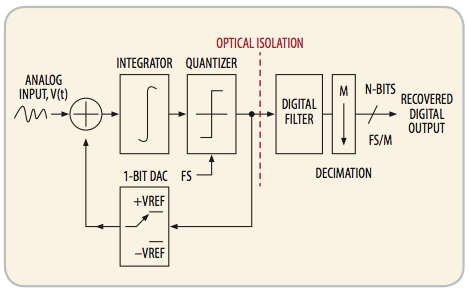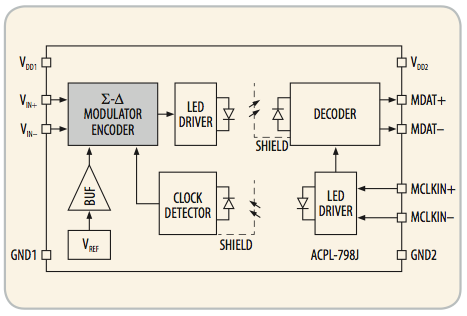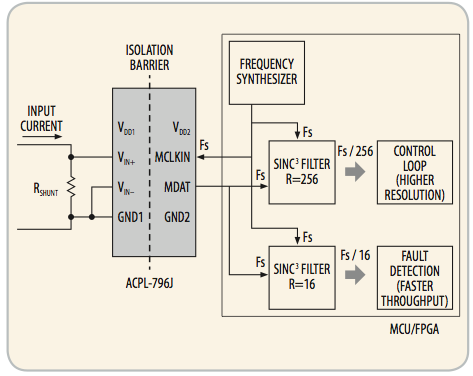Introduction
In Industrial motor or servo control applications, accurate current measurement is a critical as part of the control loop. Not only has the current measurement need to be as accurate as possible, it also needs to be safe and reliable. Industrial Motor or servo control systems usually contains high voltages and in fault events like over-current or short circuits, these conditions need to be detected and rectified quickly to prevent catastrophic systems failures or in the worst case, human injury. Not only does optocouplers help to provide isolation in breaking ground loops, rejecting common mode noise and transients, it provide the necessary insulation to meet the required safety standards and regulatory requirements.
Optically Isolated Modulator Architecture
The inputs of an isolated modulator used in current measurements are usually connected to a small shunt resistor, which converts the current passing through it to a small voltage, usually about ±200mV, so as to limit the power dissipation in the shunt resistor. The sigma delta modulator then oversamples the analog input signal into a single high speed bitstream before transmission across the optical isolation barrier. The modulator data received on the isolated side is then sent to a processor for further processing. A Sinc3 decimation filter can then be easily implemented on an FPGA or microprocessor to recover the desired signal. The decimation filter averages or decimates the high speed oversampled bitstream to a lower rate by a factor, commonly known as decimation ratio. Figure 1 shows the block diagram of an isolated sigma delta acquisition system.
 |
|
| Figure 1. | Optically Isolated Sigma Delta Modulator block diagram. |
There are a couple of advantages with such approach. Firstly, an isolation barrier can be easily placed on a single channel immediately after the modulator output. Secondly, any errors in the received bitstream that could be caused by common mode transients would have been averaged out by the decimation filter. The result is a very robust isolation scheme which provides good common mode rejection between primary and secondary or transient immunity in highly noisy environments like motor control. Being optical in nature, the device is also immune to magnetic interference unlike conventional Hall Effect sensors. Figure 2 shows a block diagram of the new Avago ACPL-798J externally clocked optically isolated Sigma-Delta Modulator with LVDS interface. The LVDS interface furthers improves the connection between the sensor and the processor as compared to the usual single ended LVTTL interface, allowing system designers to have a robust interface. The ACPL-798J also offers good gain accuracy of ±1% and 75dB of Signal to noise ratio equivalent to 12bits effective number of bits (ENOB).
 |
|
| Figure 2. | ACPL-798J block Diagram. |
Types of Optically Isolated Modulators
There are 2 types of optically isolated sigma delta modulators, internally clocked and externally clocked. An externally clocked type has certain advantages over internally clocked type. For example, externally clocked type typically has a higher clock speed. Externally clocked type also allows having a common master clock for easier data recovery and channel to channel synchronization, for example simultaneous measurements of phase currents.
Table 1. Decimation ratio vs. filter delay time illustration & ENOB

Speed and Precision
In motor or servo control, the motor loads being driven are inductive loads. From the inductor impedance equation below, one can deduce that voltage is dependent on the rate of change of the current flowing through the inductor.

Thus, fault conditions like phase to phase shorts or ground shorts need to be detected and rectified as quickly as possible before dangerous voltage levels develop on the motor which could lead to catastrophic failures as well as human injury. Typical reaction time required for the motor controller to react to such fault is usually less than 10μs. One common approach is to have separate filters with decimation ratios running in parallel (figure 3).
A filter can be configured with a smaller decimation ratio to provide the fast response required to track and react to fault conditions while having another filter in parallel with higher decimation ratio for better resolution during the normal control loop operation. By partitioning a system in such a way, it is possible to sense and react quickly to rectify any fault conditions. Table1 shows the tradeoff between resolution and speed by selecting the appropriate decimation ratio.
 |
|
| Figure 3. | Decimation filters partitioning. |
Field Safety and Reliability
Avago optocouplers are certified to the IEC safety standard IEC60747-5-5 for Reinforced Insulation. This is a component safety standard designed to test the isolation construction, insulation material, aging mechanism of optocouplers and is applicable to only optocouplers and is not applicable to alternative isolators.
As a compromise, some test houses offer certified compliance for alternative isolators to the optocoupler standard DIN/EN 60747-5-2 but have only issued certification of BASIC insulation, which implies a partial compliance but not a full certification. That is because the quality and characteristics of such thin-film polyimide and CMOS insulation with respect to safe insulation application is not well understood yet.
Avago has been manufacturing and supplying in high volumes optically isolated modulators and isolation amplifiers to many motor control customers for over close to 2 decades. This track record is testament to the safety and reliability that optical isolation provides.
Summary
Current measurement using Optical isolated sigma delta modulators offers the flexibility to configure itself between precision and speed by choosing the appropriate filtering schemes. Only optocouplers are certified to the IEC Safety Standard IEC60747-5-5 for reinforced insulation. Avago optically isolated modulators provide a field proven method to measuring current in an accurate, safe and reliable way.
